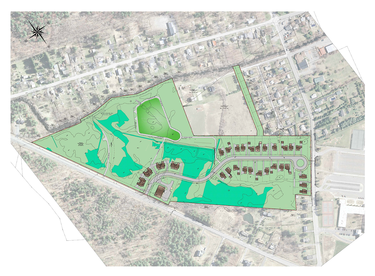Board mulls moratorium, hears protests against Black Creek Run proposal
GUILDERLAND — After nearly two hours of listening to sometimes passionate testimony from residents opposed to the Black Creek Run Country Hamlet proposal, the town board closed the hearing but took no action.
Councilwoman Christine Napierski chaired the Nov. 9 meeting in the absence of Peter Barber who was home, sick with COVID-19. While Barber typically moves the agenda swiftly forward with board members making few comments, the Nov. 9 meeting was longer than usual as each of the four board members asked questions.
Near the start of the meeting, Robyn Gray, who chairs the Guilderland Coalition for Responsible Growth, noted that all of the subcommittee reports for updating the town’s two-decades-old comprehensive plan had been submitted, and challenged the town board to declare a moratorium on development while the plan is finalized.
Napierski responded she had drafted a proposed moratorium law. “I don’t have it with me here tonight,” she said.
Gray pressed on to ask if the town board could take a look at that draft and come to the next meeting prepared to address it.
“I’ll certainly consider it,” said Napierski.
“I will as well,” said Councilwoman Amanda Beedle.
Councilman Jacob Crawford said a public hearing would have to be held.
“Well, let’s get rolling,” rejoined Gray.
“Your challenge has been placed,” said Crawford.
Crawford, who was re-elected on Nov. 7, had said during an Enterprise candidates’ forum that he was going to call for a pause on building apartments in town.
“While we’re pursuing this comprehensive plan, I think it’s time we take a pause in building large-scale apartments in the town,” he said in October. “And I think it’s something that we need to sit back and reflect on where we want to see the future development.”
Board concerns
While the board considers a pause in development, a project already in the pipeline came under fire.
Ten people spoke at the hearing on the Black Creek Run proposal — all of them against it. Those in the gallery applauded for each speaker.
Their concerns centered on increasing water problems in an area already prone to flooding and increasing traffic in an area already suffering from delays.
Nicholas Costa, owner of Advanced Engineering & Surveying, gave an overview of the Rossetti Acquisitions project. A roughly 41-acre parcel across School Road from the high school in Guilderland Center is to be developed with eight twin townhouses, 24 single-family homes, and 14 senior apartments.
About 60 percent of the land, 27 acres, Costa said, is to be conveyed to the town of Guilderland; much of it is unbuildable wetlands.
“The strip at the rear that’s owned by the developer will be conveyed to the residents that live along Nielsen Road,” said Costa.
An earlier version of the project called Dutchmen Acres — Guilderland High School’s mascot is the Flying Dutchman — lay dormant from 2009 to 2015 when the current configuration was presented to the town’s planning board.
As early as 2009, the town board raised concerns that site runoff into the Black Creek would be contaminated. The creek feeds into the Watervliet Reservoir, Guilderland’s major source of drinking water.
Rosetti, which acquired the land at 6250 Depot Road in 2014 for $306,000, proposed Country Hamlet zoning to allow far more housing units, in a clustered formation, than the Rural Agriculture 3 zoning. The Guilderland Town Board is lead agency for all Country Hamlet project applications.
Costa, responding to board questions, said the stormwater design manual from the state’s Department of Environmental Conservation was followed in designing a vegetative swale as well as bioretention and a dry swale to reduce runoff.
Councilwoman Rosemary Centi said, “I’m very concerned that the main discussion we seem to be having meeting after meeting revolves around water.”
She questioned what would happen with the proposed retention pond in a dry summer “to keep those mosquitos at bay or keep the water moving, to keep the aquatic plant life growing.”
“There’s always groundwater moving,” responded Costa, stating it would move towards the Black Creek.
Crawford asked how long it typically takes groundwater to move in the development area to which Costa replied, “We haven’t done a groundwater time study but the groundwater is continually moving.”
Beedle asked about the flow being disturbed by construction and Centi requested original documents rather than synopsis summaries.
Centi also expressed concern about a disclosure for potential buyers; the disclosure states that, due to a high water table, “dwelling units constructed with basements may require the installation of sump pumps to address or prevent issues with water in basements.”
“Why would you sell a house that’s going to have a wet basement?” asked Napierski.
Beedle said she had talked to residents of Nielsen Road and “almost every single one of their basements flooded.” She went on, “As many water mitigative measures as you’re trying to take, it screams to me that something’s not right.”
Beedle also said of the proposed retention pond for which the town would become responsible, “I call it an ocean.” She said she walked the property and declared, “The amount of mature trees and greenery that has to be cleared in order to build, construct this pond was alarming.”
Later, when Costa spoke of “a whole traffic study that was done for this project,” Beedle called it “absolute baloney.” She said the study was conducted during the pandemic shut-down when students weren’t attending the high school
Beedle said residents had been told “in a documented letter” that they’d have to leave for work 15 minutes early. “I already leave early enough for work in the morning and it still takes me almost 45 minutes to get from Altamont to Albany-Shaker Road,” she said.
Citizens object
Michael Mckinney of 508 Route 146, whose home is directly across from the proposed development, noted the clay soil and said, “When it rains, even moderately, the back half of my yard will just fill up with water and it’ll be there for three or four days before it migrates out.”
He also spoke of the heavy traffic and many accidents on his road, and at one point shouted, “No! No! … I just am appalled that we would even consider this.”
He also said, “I moved out here for a little peace and quiet and I ain’t getting it no more.”
Steve Wilson of Stitt Road said his “number one” concern was water and cited the Albany County Soil Survey that says the area is largely clay, which “means very, very poor draining.”
He recalled more than 40 years ago buying hay from Mike Canaday who was farming the site “who couldn’t put his equipment on the field, it was so wet.”
Wilson called the Normanskill drainage basin, including the Black Creek, “part of a flashy drainage system — that means that, once you get a really heavy downpour, the water piles up very fast.”
Amanda Connors said that, in early June, “My significant other and I purchased a house … the newest house on Depot Road.”
She apologized for “getting a little choked up” but asked the board to imagine spending years “saving for your dream home and having that turn on you.”
Connors went on, “We joke that we live in a castle because there is water all around us constantly.”
Their house, built in 2023, has “all the bells and whistles” meant to control water like a French moat and a sump pump but still the basement flooded, ruining the possessions they stored there and dashing their dreams to finish the basement as living space.
“We’re stuck,” said Connors.
She imagined that the same thing would happen to “older millennials like me” who would buy homes in the proposed Black Creek Run development.
Connors concluded to applause, “It is a shitty feeling when you buy your dream home and you realize that the basement that you wanted to finish, that’s not a reality … Protecting your items that are downstairs in the basement, that’s the reality.”
Tony Rigosu, whose property fronts Depot Road, asked the board, if the development were to be approved, if a culvert pipe for stormwater could be moved and that no additional stormwater be created by the subdivision.
Sue Green, who lives where the Black Creek and Bozenkill merge, said, “Water does what it wants to do when it gets strong enough. I’ve lived there long enough to see the Bozenkill push the Black Creek backwards.”
Green also said, “We’ve seen too many builders build and then disappear and leave … The other thing is the audacity to call it a country hamlet when all they’re doing is destroying the countryside.”
Gerd Beckmann, who lives on Route 146, brought in a dish with two straw “pipes” as a model for the four-acre retention pond meant to illustrate problems with the plan.
“In order for this to pass,” he said, “this board has to determine it’s in the best interest of the community ….The developer is going to change the quality of life for people who live in both the immediate area as well as people who potentially come to the area.”
Beckmann concluded of the planned clustered development, “We’re trying to put too much shit in the box.”
Mike Moak, with his wife, Heidi, owns a nine-acre property next to the planned development where they run a small horse farm.
“We have lived here for nearly a quarter century and have had a front-row seat to this proposal for about 20 years,” said Moak.
“When we first purchased our property,” he said, “I spoke with Jan Weston, the town planner at the time, about rumors this area was being considered for development. Ms. Weston said at the time, ‘They’ve wanted to build there for years. But it’s all wetlands. It’ll never happen.’ But proposals were put forth constantly changing in scope and scale over the years.”
Moak cited the impermeable soil, high water table, numerous wetlands, and proximity to the Black Creek as concerns. And he described all the expensive mitigation efforts he had undertaken over the years.
To create the retention pond, Moak said, “Hundred of trees and brush will need to be cut down and uprooted. Using conservative calculations, I determined that over 24,000 cubic yards of soil will need to be excavated. That is enough dirt and rocks to fill over 1,500 full-size 14-wheel dump trucks.”
Moak went on, “What we need to ask is this: If it is necessary to create something this extensive in size and scope in order to handle a problem, isn’t it better to not create the problem in the first place?
“Not every open space in the town of Guilderland should be seen as an opportunity for development. Some areas are simply not suitable for building. This is clearly one of those areas.”
“Every single thing that every speaker has gotten up here and said is extremely important,” said Gray, stating that she was speaking on behalf of the Guilderland Coalition of Responsible Growth in opposing the project.
Gray went on, “I don’t think we should be blinded by the amount of land that is being dedicated to the town. I don’t think it’s worth it … A country hamlet is a wonderful idea; just like Costco, this is not the place for it.”
Ted Neumann of Altamont noted that hamlets had been “recommended for Route 20 — not here.” To be a walkable community, he said, the homes would have to have access to public transportation.
“This is just more traffic-inducing,” Neumann said of the proposal.
He also said that, if the development is approved, “The town is going to be stuck, not with lovely parkland. They’re going to have a responsibility and an insurance problem because anything could happen with this pond.”
If it overflowed, he said, the town would be open to lawsuits.
After most of the public had spoken, the town engineer, Jesse Fraine, answered questions from the board.
“There’s no question this is a difficult site,” said Fraine. “There’s many hurdles to get over. From a stormwater-design standpoint, in looking at the guidance that DEC puts out and their requirements, this design does satisfy that.”
After more questions, Fraine concluded, “It meets the requirements ,and there’s gray area with how much … it’s over the requirements but it’s not under the requirements.”
Finally, a Nielsen Road resident, who gave her name only as Barbara, stepped to the microphone to hesitantly speak to the board.
She said she had formerly lived on the second floor of a two-story house in back of the Black Creek. “I could see it rise 15 or 20 feet in the spring into the yard,” she said.
Of her current Nielsen Road home, where she has lived for 13 years, she said, “It’s always wet. It rains hard, it gets in my basement already.”
“I think everyone’s had their say,” said Napierski, closing the hearing. “And they still can send us emails and information that they want. We’re not going to make a decision tonight.”


